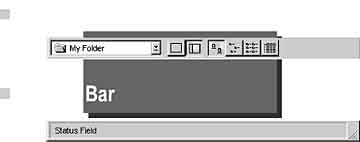General Purpose Controls
Organizational Controls
There are two organizational controls: the Toolbar and the Status Bar. 
Toolbar
A toolbar is a frame that contains a set of controls. Toolbars often are used to give the user quick access to specific commands or options. The toolbar in our example displays a drop-down combo box containing the current directory and several icons that allow the user to manipulate files and directories. There should be command equivalents in the menu for all of the controls on a toolbar.A toolbar can be fixed or movable. If it is movable, it appears inside its own window and should be designed so it can be windowed or docked whenever the user chooses to change its position. A toolbar is " docked " when it is fixed to any of the four borders of the application window.
Status Bar
A status bar is a special area at the bottom of a window that displays information, such as the current date or a custom message from the application. This area reflects the current state of the object that is being viewed in the window, or displays other relevant information about the object or operations that can be performed on the object.Like a toolbar, a status bar can contain controls; however, these controls typically reflect status or state information. A status bar usually is configured as part of a window.
Microsoft Windows Architecture for Developers Training Kit
ISBN: B00007FY9D
EAN: N/A
EAN: N/A
Year: 1998
Pages: 324
Pages: 324
Authors: Microsoft Corporation